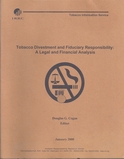Venable LLP
600 Massachusetts Avenue, NW
Washington, DC 20001
Phone: (202) 344-4715
Fax: (202) 344-8300
Mobile: (202) 441-5592
E-mail: Click here to send e-mail.

WASHINGTON, D.C. – Most pension funds and university endowments are still holding tobacco stocks, despite the industry’s mounting legal problems and recent poor showing on Wall Street, finds a new study by the impartial Investor Responsibility Research Center.
Six states, nearly 10 major municipalities and more than 15 colleges and universities have set policies to restrict or divest tobacco stocks—far fewer than divested holdings of companies doing business in South Africa during the apartheid era that ended nearly a decade ago. No major tobacco divestment actions occurred in 1999, even though tobacco was the third worst performing industry out of 103 groups tracked by Standard & Poor’s. The sharp decline in tobacco share prices is fueling another round of divestment actions in 2000, however.
On Jan. 21, 2000, the University of Washington became the first state university system to divest its tobacco shares, and pressure is mounting elsewhere—including on California’s giant pension funds. (See fact sheet.) From 1996 through 1999, institutional decisions resulted in divestment of more than $1.5 billion of tobacco holdings and restrictions on another $1 billion of tobacco holdings. Public pension funds comprise most of this "third wave" of tobacco divestment activity. Earlier waves came in the mid-1980s when public health groups like the American Medical Association and American Cancer Society sold their tobacco shares, and in the early 1990s when schools like Harvard and Johns Hopkins instituted similar divestment policies.
"Some arguments for holding tobacco stocks are getting turned on their head,"says Doug Cogan, who produced the new IRRC report, Tobacco Divestment and Fiduciary Responsibility. Major institutional fund managers like Barclays Global Investors are launching tobacco-free index funds as alternatives to traditional indexes that include industry giant Philip Morris. Once a high-flier, Philip Morris had a return on investment in the 1990s that was only about half that of the S&P 500 and posted the worst performance of all major tobacco stocks in 1999. As a result, funds that have divested Philip Morris and other tobacco stocks can argue—for the moment at least—that they are doing a better job of maximizing returns for beneficiaries.
Kicking Tobacco Investing Habit Isn’t Easy
Most investing institutions have been reluctant to part with their tobacco shares for three reasons, explains Cogan, director of IRRC’s Tobacco Information Service. "First, tobacco stocks were very profitable to own before the 1990s and have always been regarded as good defensive plays. Second, tobacco stocks are still found in all of the major indexes, like the Standard & Poor’s 500 and the Russell 3000, so index investors hold them automatically. Third, institutional funds have shied away from outright divestment of these stocks to avoid the ‘slippery slope’ where social concerns come before their duty to maximize returns for beneficiaries. Today, it’s tobacco. Tomorrow, will it be gun makers?"
Past stock price performance is not the basis on which fiduciaries should make future tobacco investment or divestment decisions, the IRRC study emphasizes. Rather, fiduciaries must be forward-looking as they seek to secure the retirement incomes of plan beneficiaries—taking into account "societal shifts that may affect investments over the long term, even if not in the short term," according to the legal analysis written for IRRC by the law firm of Conner & Winters.
"This finding raises an important question for fiduciaries," says Cogan. "Will they speculate that the societal shift against tobacco is going to continue, or do they think investor sentiment will swing back in favor of the industry eventually? While many fiduciaries think it is best to let the market preside over the fate of their tobacco investments, some are feeling compelled to take this matter into their own hands."
The IRRC study predicts that a fourth wave of "tobacco-free investing" may involve the huge Master Settlement Agreement in which the major tobacco companies have agreed to pay the states an estimated $246 billion over 25 years (and more money in perpetuity if tobacco sales remain robust). Since the actual size of payments is tied to future tobacco sales, some states are opting for up-front payments to insulate themselves from the risk that tobacco companies might someday declare bankruptcy. Any investments of these lump-sum payments may well avoid tobacco securities as a further precaution.
"Since some legislators would rather see tobacco sales fall to zero than depend on those sales as a future source of government funding," Cogan observes, "it follows that they would shun investments in an industry they hope will shrink and whither away over the life of the settlement agreement."
| Tobacco Divestment and Fiduciary Responsibility: A Legal and Financial Analysis, was made possible by a grant from The Robert Wood Johnson Foundation, the largest U.S. foundation devoted to health care. The study has been published by the Investor Responsibility Research Center, an independent, not-for-profit firm funded mainly by institutional investors. IRRC takes no advocacy positions on the policy questions it addresses.
The 200-page tobacco study is divided into five chapters, including an executive summary, a history of tobacco divestment and a history of shareholder activism on tobacco issues. Outside groups wrote two chapters. The BARRA RogersCasey consulting firm provided an historical analysis of the performance attributes of tobacco stocks as well as the transaction costs associated with tobacco divestment. The Conner & Winters law firm wrote an analysis of fiduciary questions raised by tobacco divestment (and social screening generally) for a range of retirement and endowment plans. An appendix has the results of an investment survey sent to 437 institutions. |

